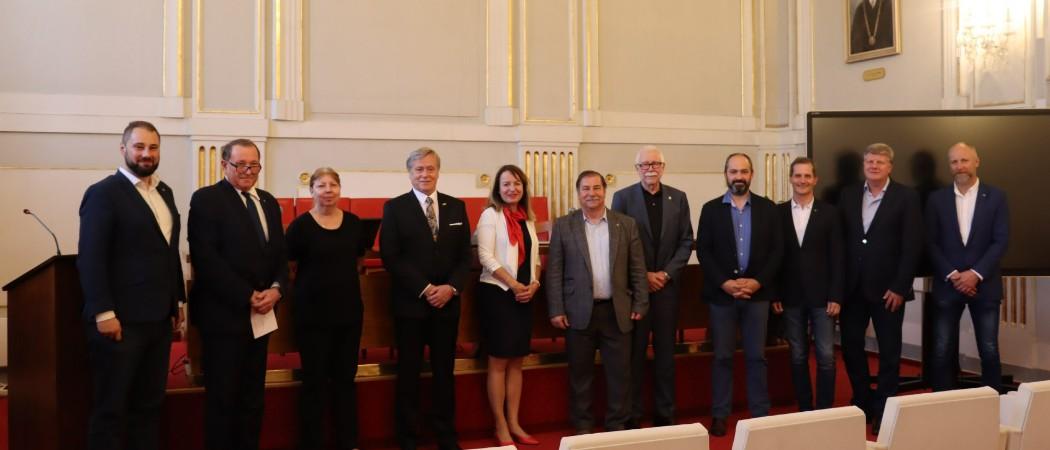The Cassovia New Industry Cluster launched in 2021 with the aim of bringing universities and industry together to increase the industrial competitiveness of an economically deprived region

The CNIC general assembly meeting took place on June 1, 2022 in Cassovia. Photo: CNIC
Universities in eastern Slovakia hope a new research and innovation cluster will give an economic boost to the Prešov and Košice regions on the border with Ukraine. Stakeholders are now advertising the project to policymakers in Brussels, while hoping their government will unlock money from the EU pandemic recovery fund.
The Cassovia New Industry Cluster (CNIC) was launched in 2021 through a partnership between the local government and Košice’s three universities, Šafárik University, the Technical University and the University of Veterinary Medicine, in an attempt to raise the contribution of the region makes to the Slovakian economy and stop young and skilled people brain draining away.
Cassovia is the Latinised name of Košice, one of the two easternmost regions of Slovakia that currently account for only 14.4% of the country’s gross domestic product, while nearly 70% of economic output is concentrated in the western regions around the capital of Bratislava.
The Universities in Košice are bent on changing this over the next couple of decades. “One of our biggest goals is to establish efficient cooperation with industry,” Pavol Sovák, rector of Šafárik University told Science|Business, speaking after an event promoting the Cassovia cluster in Brussels last week.
The Cassovia cluster has already signed memorandums of understanding with companies including Slovak-American microchip manufacturer Tachyum, which will work with the cluster on artificial intelligence projects, with plans to build a supercomputer in the region.
The cluster has also joined forces with the regional chamber of commerce and industry. The government agency says the Cassovia cluster will boost the regional innovation ecosystem.
But universities could do more to boost the scientific competitiveness of the region, said Sovák. Šafárik University has built three science parks in medicine, ICT and advanced materials, with some €100 million in EU structural funds.
University mergers
The cluster is set to receive additional funding from the EU’s sweeping pandemic recovery fund aimed at helping regions and member states get through the post-COVID-19 economic slump. However, in its investment plan submitted to Brussels, the Slovak government proposed the money would be spent more efficiently if the three universities in Košice were to merge.
“The cluster is our model on how to merge the potential of universities in Košice,” said Sovák.
However, the three higher education institutions in the Cassovia cluster began haggling over the merger, with some university leaders flat out rejecting such a prospect. The University of Veterinary Medicine said a merger that would erase its legal identity which would be unacceptable and that it would favour a looser partnership that covers joint research and development activities.
Meanwhile, the University of Šafárik argues small and medium-sized universities have no chance of competing in international competitions against much bigger academic institutions with well endowed scientific infrastructures and a large body of administrative support staff.
Sovák said some universities must accept that decisions taken decades ago to establish a flurry of public universities in Slovakia are not compatible with the current state of play in European research and innovation policy. Other EU countries, including France, have taken steps to merge academic institutions in order to strengthen their international competitiveness.
“Our decision is to do what is necessary to have in Slovakia two centres, Bratislava and Košice, that can play a very important role in the European Research Area,” said Sovák.
Slovakia still ranks low in the European Commission’s innovation scoreboard. The 2022 report notes that low R&D expenditure in the private sector and low government support for business R&D are the country’s most obvious weaknesses. R&D expenditure hovers just under 1% of GDP, well below the 2.3% EU average.
However, according to Sovák, an immediate boost in R&D spending would not do miracles. First, the government and research institutions need to work together to “create an environment to be ready for this competition” in the European Research Area.





 A unique international forum for public research organisations and companies to connect their external engagement with strategic interests around their R&D system.
A unique international forum for public research organisations and companies to connect their external engagement with strategic interests around their R&D system.